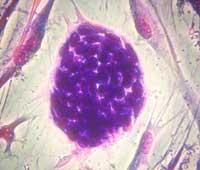Sperm, initially in laboratory

The starting point was embryonic stem cells: embryos are initially only a series of cells that have no special function or characteristic. As the pregnancy progresses, the cells differentiate and acquire the necessary characteristics to perform their function in the part of the body that has touched them: some form the heart, others, bones, brain, intestines, liver... and reproductive cells.
Therefore, in principle, the presence of an embryonic cell group can lead to the creation of any part of the body, being the only one that must be performed in adequate conditions of growth. This is what researchers at Newcastle University did: they put the cells in a medium that pushes them to become sperm. The result was that cells with caudal cells were extracted from embryonic cells. Like sperm.

The presence of a cellular group of embryos allows the spontaneous formation of any part of the body (Photo: M. William Lensch; Harvard Medical School)
Sufficient DNA
However, sperm, in addition to their ability to move, must necessarily have another characteristic, which is to multiply to properly fulfill their function: they have half DNA than the rest of the body's cells. Half of the DNA we each have in the cells is given by the mother and the other half by the father. For this, eggs and sperm should lower the amount of DNA in half.
This is due to a process called meiosis, in which cells that will be sperm or eggs are divided into two, each representing half of the DNA that contained the original cell. Meiosis occurs naturally in our body, but in the laboratory it is especially difficult to induce. Approximately 3% of the cells cultivated by Newcastle researchers contained the corresponding amount of DNA.

In fact, more than an adequate amount of DNA are necessary requirements to be a true sperm, among other things, that the proteins that accompany DNA and other compounds are in the quantities and places that are necessary. Otherwise, the human being resulting from the union of these sperm with some bone would suffer various anomalies.
Researchers have not been able to tell whether or not the sperm generated in the laboratory have these characteristics and have shown that they have not created normal sperm. However, they have shown their satisfaction by having seen that, at least, it is possible to create sperm from embryonic stem cells.
Sperm, human
In the experiment, they have also been able to confirm that the creation of sperm is men's thing, or please. Or in other words, that female or female cells cannot produce sperm.
The researchers conducted the experiment with two types of embryos, which boys and girls would give. The difference between men and women is determined by a specific chromosome, the Y chromosome, that men have and women do not. Instead, women have repeated another chromosome, X.
As cells without Y chromosome did not become sperm. Therefore, scientists have considered that genes present in the Y chromosome are essential for cells oriented to be sperm.
Published in 7K.
Buletina
Bidali zure helbide elektronikoa eta jaso asteroko buletina zure sarrera-ontzian











